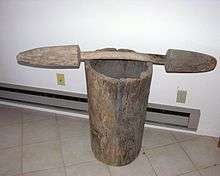Bunce Island
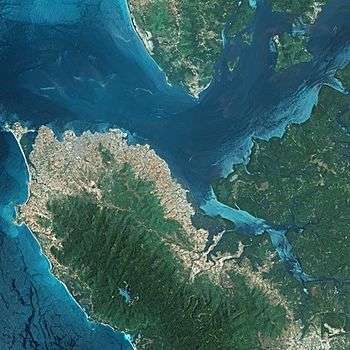 A satellite picture of Freetown, 2006. | |
 Bunce Island | |
| Geography | |
|---|---|
| Location | Sierra Leone River |
| Coordinates | 8°34′N 13°02′W / 8.567°N 13.033°W |
| Administration | |
| Additional information | |
| Time zone | |
Bunce Island (also spelled "Bence," "Bense," or "Bance" at different periods) is an island in the Sierra Leone River. It is situated in Freetown Harbour, the estuary of the Rokel River and Port Loko Creek, about 20 miles (32 kilometres) upriver from Sierra Leone's capital city Freetown. The island measures about 1,650 feet (502.9 metres) by 350 feet (106.7 metres) and houses a castle that was built by a British slave-trading company in c.1670. Tens of thousands of Africans were shipped from here to the North American colonies of South Carolina and Georgia to be forced into slavery, and are the ancestors of many African Americans of the United States.
Although the island is small, its strategic position at the limit of navigation for ocean-going ships in Africa's largest natural harbour made it an ideal base for European slave traders.[1][2] To mark the 2007–2008 bicentennial of Great Britain's abolition of the African slave trade, a team at James Madison University created a three-dimensional animation of the castle as it was in 1805, and an exhibit on the site that was displayed to museums all across the U.S. which is now held by the Sierra Leone National Museum.[3]
History
Bunce Island was first settled and fortified by English slave traders in c. 1670. During its early history, the castle was operated by two London-based firms the Royal African Company and its offshoot, the Gambia Adventurers, the latter a "Crown-chartered company" or parastatal subsidised by the English government. The castle was not commercially successful but it served as a symbol of English influence in the region, where Portuguese slave traders had been established since the 1500s.[4][5][6]
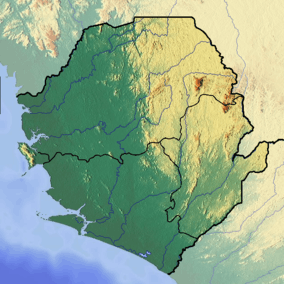
The early phase of the castle's history ended in 1728 when Bunce Island was raided by José Lopez da Moura, a Luso-African slave trader based in the area. He was the richest man in present-day territory of Sierra Leone, the grandson of a Mane king and part of the hybrid Luso-African community that had developed along the lower rivers. This class acted as middlemen, resisting efforts by the Royal African Company to monopolise trade with African rulers. Lopez led others in destroying the Bunce Island factory.[7][8][6]
Bunce Island was abandoned until the mid-1740s. It was later operated by the London-based firm Grant, Oswald & Company, who took over in 1748.[9] In 1785 Bunce and a number of other dependent islands were conveyed to the company of John and Alexander Anderson.[6]:286[10] Throughout the late 18th century, it was a highly profitable enterprise. During the second half of the 18th century, the companies sent thousands of African captives from Bunce Island to sales for plantations on the British- and French-controlled islands in the West Indies, and to Britain's North American colonies. The London-based owners grew wealthy from the castle's operations.[4][8][6]
The slave traders who did business at Bunce Island came from a variety of backgrounds. During the castle's early history, Afro-Portuguese—part of what historian Ira Berlin described as the "Atlantic Creole generation"—sold slaves and local products there. They were well-established along the rivers near the coast and were descendants of male Portuguese slave traders known as lançados and African women, and were often bilingual.[7][8][5][6] During the island's later history, Afro-English dynasties became established in communities along the West African coast, beginning in the 17th century. By 1800, there were about 12,000 Afro-English in this area.[7] Mixed-race men from such families as the Caulkers, Tuckers and Clevelands sold slaves and traded goods at Bunce Island. Like the Portuguese descendants, they occupied a middle ground, often marrying into the upper classes of African tribes.[7] The slave ships came from London, Liverpool and Bristol; from Newport, Rhode Island in the North American colonies; and from France and Denmark. They transported slaves mostly to British markets in the Caribbean and the American South.[4][8][6]
Bunce Island was an important British commercial outpost and an attractive target during times of war. French naval forces attacked the castle four times (1695, 1704, 1779, and 1794), damaging or destroying it each time. The attack of 1779 took place during the American Revolutionary War when the rebel Continental Army's French allies took advantage of the conflict to attack British assets outside North America. Pirates, including Bartholomew Roberts or "Black Bart", the most notorious pirate of the 18th century, attacked in 1719 and 1720. The British traders rebuilt the castle after each attack, gradually altering its architecture during the roughly 140 years it was used as a slave trade entrepôt.[4][8]
Links to North America
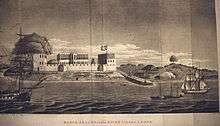
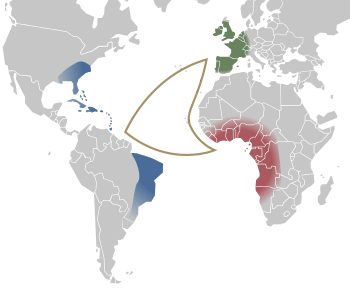
Bunce Island is best known as one of the chief processing points for slaves to be sold to planters in Lowcountry of the British colonies of South Carolina and Georgia, including the Sea Islands, where they developed extensive rice plantations. Rice requires a great deal of technical knowledge for its successful cultivation. South Carolina and Georgia planters were willing to pay premium prices for slave labour brought from what they called the "Rice Coast" of West Africa, the traditional rice-growing region stretching from what is now Senegal and Gambia in the north down to present-day Sierra Leone and Liberia in the south. Still, records of the port of Charleston show that nearly 40 percent of the slaves came from Angola.[12][13]
Bunce Island was the largest British slave castle on the Rice Coast. African farmers with rice-growing skills were kidnapped from inland areas and sold at the castle or at one of its many "outfactories" (trading posts) along the coast before being transported to North America. Several thousand slaves from Bunce Island were taken to the ports of Charleston (South Carolina) and Savannah (Georgia) during the second half of the 18th century. Slave auction advertisements in those cities often announced slave cargoes arriving from "Bance" or "Bense" Island.
Colonist Henry Laurens served as Bunce Island's business agent in Charleston, and was a wealthy rice planter and slave dealer. He later was elected as President of the Continental Congress during the Revolutionary War, and was later appointed as the United States envoy to the Netherlands. Captured by the British en route to his post in Europe during the war, he was imprisoned in the Tower of London. After hostilities ended, he became one of the Peace Commissioners who negotiated United States independence under the Treaty of Paris. The chief negotiator on the British side was Richard Oswald, the principal owner of Bunce Island; he and Laurens had been friends for 30 years. The United States independence was negotiated in part between the British owner of Bunce Island and his American business agent in South Carolina, demonstrating the wealth and status achieved by these men by their trade in rice and slaves.
Bunce Island was also linked to the Northern colonies in America. Slave ships based in northern ports frequently called at Bunce Island, taking on supplies such as fresh water and provisions for the Atlantic crossing, and buying slaves for sale in the British islands of the West Indies and the Southern Colonies. The North American slave ships that called at Bunce Island were sailing out of Newport (Rhode Island), New London (Connecticut), Salem (Massachusetts), and New York City.
Decline of Bunce Island
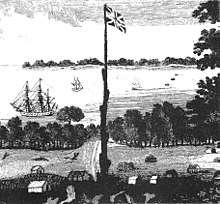
In 1787 British philanthropists involved with the Committee for the Relief of the Black Poor in London established Granville Town, a settlement for freed slaves on the Sierra Leone Peninsula, 20 miles (32 kilometres) down-river from Bunce Island. This first attempt at colonisation was unsuccessful and in March 1792, the settlement of Freetown was founded as the basis for the second and only permanent Colony of Sierra Leone.[14] The Atlantic slave trade continued to be legal for the next two decades.[5][15] During that period, Bunce Island slave traders harassed the fledgling colony by inciting local African chiefs against it, organising trade boycotts to isolate it and, at one point kidnapping and selling some Freetown colonists whom they accused of stealing goods at the castle as slaves.
In 1807 the UK Parliament abolished the Atlantic slave trade.[16] The following year Freetown became a Crown Colony[17] and the Royal Navy based its Africa Squadron there. They sent regular patrols to search for slave vessels violating the ban. Bunce Island was shut down for slave-trading; British firms used the castle as a cotton plantation, a trading post and a sawmill. These activities were economically unsuccessful and the island was abandoned around 1840, after which the buildings and stone walls deteriorated.[13]
As of 2016, substantial ruins stand on the northern end of the island. Bance Island House, the headquarters building where the Chief Agent lived with his senior officers, is at the centre of the castle. Parts of the building still rise to second-story level. Immediately behind it is the open-air slave yard, which is divided between a large area for men and a smaller one for women and children. Remnants of two watchtowers, a fortification with places for eight cannons, and a gunpowder magazine remain standing. Some of the cannons bear the royal cypher of King George III. At the south end of the island, several inscribed tombstones mark the graves of slave traders, slave ship captains, and the foreman of African workers.[14]
Research on Bunce Island
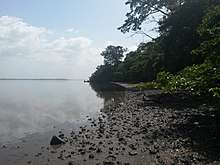
Three American scholars have researched Bunce Island. Anthropologist Joseph Opala's research linked the island to the Gullah people of the United States Low Country. He organised the Gullah "homecomings" portrayed in the documentary films: Family Across the Sea (1990), The Language You Cry In (1998), and the website, Priscilla’s Homecoming (2005).[18] Historian David Hancock documented Bunce Island during the period of Grant, Oswald & Company in his study, Citizens of the World (1997). Archaeologist Christopher DeCorse and his team surveyed the island’s ruins for a report submitted to the Sierra Leone government (2006).
In 2006, television actor Isaiah Washington visited the island after learning through a DNA test he was descended from the indigenous Mende people of Sierra Leone.[19] Washington later donated US$25,000 to a project to create a computer reconstruction of Bunce Island as it appeared in 1805, to mark the bicentenniel of the abolition of the African slave trade by the UK and the United States.[3] A reconstructed slave ship was docked at the island.[19]
Project directors Joseph Opala and Gary Chatelain at James Madison University created a three-dimensional image of the castle using computer-aided design and historic drawings. It is part of an exhibit portraying the island's history and depicts the buildings as they appeared 200 years ago.[19] A travelling exhibit on the history of Bunce Island is available in the US and UK, and the full exhibit is on permanent display at the Sierra Leone National Museum in Freetown.
Evidence of numerous historical and genealogical links between Bunce Island and the United States has been found. In 2013 historians reported learning that two U.S. presidents, George H. W. Bush and George W. Bush, are directly descended from a slave-ship captain who operated out of Bunce Island and other ports in the Sierra Leone region in the late 1700s.[20] Their ancestor Thomas Walker (AKA "Beau Walker") came from Bristol, one of Britain's principal slaving ports. Walker was involved in 11 slaving expeditions; he immigrated with his fortune to the US, where he became naturalised in 1792. One of his descendants, Dorothy (Walker) Bush, was the mother of George H.W. Bush.[20]
Conservation
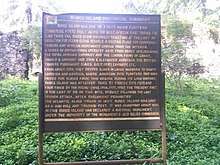
In 1948, Bunce Island was designated Sierra Leone's first officially protected historic site. The same year, Sierra Leonean amateur historian and medical doctor M.C.F. Easmon led an expedition that cleared the vegetation, mapped the ruins and photographed them for the first time. Research at the island has been underway since the 1970s. A hurricane struck in 1974, damaging structures.[5][21]
In 1989, a group of Gullahs from the United States made a visit to Sierra Leone and toured the island's ruins. Shortly after that, the U.S. National Park Service announced a preservation program for the castle in coordination with the Sierra Leone government. Plans were delayed by the lengthy Sierra Leone Civil War. African Americans visited the site in 1997 and 2005, which were documented as public history projects.
Bunce Island is now protected by the Sierra Leonean Monuments and Relics Commission, a branch of the country's Ministry of Tourism and Culture. The government is working to preserve the castle as an important historic site and as a destination for tourists, especially African Americans. Bunce Island has been called "the most important historic site in Africa for the United States"[3] because thousands of slaves were shipped from here to ports in the American South. Gorée Island in Senegal has become better known than Bunce and has attracted African-American tourists and support for preservation since the 1980s.[21][22][23]
The U.S. National Park Service team that surveyed the castle in 1989 suggested stabilising the ruins and recommended the installation of all-weather displays of the buildings' appearances and uses. No historic preservation work has been done; the ruins are deteriorating rapidly in Sierra Leone’s tropical climate. The World Monuments Fund placed Bunce Island and other historic sites in Sierra Leone on its 2008 watch list of the world’s "100 Most Endangered Sites". Several organisations in Sierra Leone, the US and the UK are promoting popular awareness of Bunce Island and its history, and working toward the preservation of the castle.
In October 2010, the Bunce Island Coalition (US) and its local partner organisation announced the start of the Bunce Island Preservation Project, a five-year, US$5 million effort to preserve the ruins of the castle as a historic landmark and to build a museum in Freetown devoted to the island's history and the influence of the Atlantic slave trade in Sierra Leone.[24]
Notable visitors
General Colin Powell, then Chairman of the US Joint Chiefs of Staff, visited Bunce Island in 1992 while on an official visit to Sierra Leone. Powell spoke of his feelings in a farewell speech he made before leaving the country; "I am an American ... but today, I am something more ... I am an African too ... I feel my roots here in this continent".[3][25]
Climate
Like the rest of Sierra Leone, Bunce Island has a tropical climate with a rainy season that runs from May to October; the balance of the year represents the dry season. At the beginning and end of the rainy season, strong thunderstorms occur. Under the Köppen climate classification, Bunce Island has a tropical monsoon climate, mainy because of the large quantity of precipitation it receives during the rainy season.
Between November and February, humidity is moderated by the Harmattan, a wind blowing from the Sahara Desert, giving the island its coolest period of the year. Temperature extremes recorded in Freetown 20 mi (32 km) from Bunce are from 17 to 41 °C (63 to 106 °F) all year. The average annual temperature is around 27 °C (81 °F).
References
Bibliography
- Opala, Joseph (2007). Bunce Island: A British Slave Castle in Sierra Leone (Historical Summary). DeCorse.
Citations
- ↑ Duthiers, Vladimir; Kermeliotis, Teo (16 May 2013). "'Slave trade ghost town': The dark history of Bunce Island". edition.cnn.com. CNN.com. Retrieved 9 April 2016.
- ↑ "A closer look at Bunce Island". World Monuments Fund. 8 April 2016.
- 1 2 3 4 Bunce Island: A British Slave Castle in Sierra Leone", Official website, Bunce Island exhibit, accessed 25 February 2014
- 1 2 3 4 Opala, Joseph (4 May 2011). "US Slave - Bunce Island Slavery". usslave.blogspot.co.uk. The Gilder Lehrman Center for the Study of Slavery, Resistance, and Abolition. Retrieved 8 April 2016.
- 1 2 3 4 Fortin, Jacey (7 February 2012). "Forgotten Island: How Sierra Leone Plans To Use Slavery Legacy To Boost Tourism". www.ibtimes.com. International Business Times.
- 1 2 3 4 5 6 "Bance Island opens for Slave Trade". www.aaregistry.org. African American Registry. 8 April 2016.
- 1 2 3 4 Bethwell A. Ogot, Africa from the Sixteenth to the Eighteenth Century, General History of Africa, Vol. 5, UNESCO, 1992, pp. 396–397
- 1 2 3 4 5 Opala 2007, chpt. 2
- ↑ Hochschild, Adam (2006). Bury the Chains. Mariner Books. p. 25. ISBN 978-0-618-10469-7.
- ↑ George, Claude (1967). The Rise of British West Africa: Comprising the Early History of the Colony of Sierra Leone, the Gambia, Lagos, Gold Coast, Etc. New York: Psychology Press.
|access-date=requires|url=(help) - ↑ McKissack, Patricia C.; McKissack, Frederick (1995). The Royal Kingdoms of Ghana, Mali, and Songhay. p. 109. ISBN 0805042598.
- ↑ Louis Gates Jr., Henry; Pironti, Eileen (1 November 2013). "From Which Port Was Slave Ancestor Sold?". www.theroot.com. TheRoot.com. Retrieved 9 April 2016.
- 1 2 Joshua,, Foer,. Atlas Obscura. Thuras, Dylan,, Morton, Ella,. New York. ISBN 9780761169086. OCLC 959200507.
- 1 2 Schama, Simon (26 June 2006). Rough Crossings. Retrieved 9 April 2016. Rough Crossings: Britain, the Slaves and the American Revolution
- ↑ Shaw, Rosalind, Memories of the Slave Trade: Ritual and the Historical Imagination in Sierra Leone. Reconstructed by Mohamed Sheriff, Memphis, Tennessee, University of Chicago Press (2002), p. 37.
- ↑ Clarkson, T., History of the Rise, Progress and Accomplishment of the Abolition of the African Slave Trade by the British Parliament, London, 1808.
- ↑ Adderley, Rosanne Marion (2006). "New negroes from Africa" slave trade abolition and free African settlement in the nineteenth-century Caribbean. Bloomington: Indiana University Press. ISBN 978-0-253-21827-8.
- ↑ Priscilla's Homecoming website, Gilder Lehrman Center, Yale University, accessed 25 February 2014
- 1 2 3 James Knight and Katrina Manson, "Sierra Leone Draws Americans Seeking Slave Roots", Reuters, 22 March 2007
- 1 2 Simon Akam, "George W. Bush’s Great-Great-Great-Great-Grandfather Was a Slave Trader", Slate, 20 June 2013
- 1 2 JAMES BROOKE, "A Slave Island Draws Descendants of Slaves", New York Times, 8 November 1987, accessed 25 February 2014
- ↑ Curtin, Philip. "Goree and the Atlantic Slave Trade". History Net.
- ↑ Les Guides Bleus: Afrique de l'Ouest (1958 ed.), p.123 (in French)
- ↑ Inside Africa: Vladimir Duthiers and Teo Kermeliotis, "'Slave trade ghost town': The dark history of Bunce Island", CNN, 16 May 2013 (see text, photos, and video), accessed 25 February 2014
- ↑ Opala, Joseph. "Bunce Island Slave castle". Bunce Island Project. Retrieved 18 March 2016.
Further reading
- Ball, Edward. (1998) Slaves in the Family, New York: Farrar, Straus, & Giroux.
- Brooks, George. (2003) Eurafricans in Western Africa: Commerce, Social Status, Gender, and Religious Observance from the Sixteenth to the Eighteenth Century, Athens: Ohio University Press.
- DeCorse, Christopher. (2007) "Bunce Island Cultural Resource Assessment," Report prepared for the U.S. Embassy in Sierra Leone and the Sierra Leone Monuments and Relics Commission.
- Farrow, Anne, Joel Lang & Jenifer Frank. (2005) Complicity: How the North Promoted, Prolonged, and Profited from Slavery, New York: Ballantine Books.
- Fyfe, Christopher. (1962) A History of Sierra Leone, London: Oxford University Press.
- Hancock, David. (1995) "Citizens of the World: London Merchants and the Integration of the British Atlantic Community, 1735–1785, Cambridge: Cambridge University Press.
- Landsman, Ned C. (2001) Nation and Province in the First British Empire: Scotland and the Americas, 1600–1800, Cranbury, NJ: Bucknell University Press.
- Kup, Alexander Peter. (1961) A History of Sierra Leone, 1400–1787, Cambridge: Cambridge University Press.
- Opala, Joseph. (2007) "Bunce Island: A British Slave Castle in Sierra Leone (Historical Summary)" in DeCorse (2007).
- Rodney, Walter. (1970) A History of the Upper Guinea Coast, 1545–1800, Oxford: Clarendon Press.
External links
Historical importance
- Bunce Island: A British Slave Castle in Sierra Leone", Official website for the Bunce Island exhibit
- Joseph A. Opala, "Bunce Island in Sierra Leone", The Gullah: Rice, Slavery and the Sierre Leone-American Connection, 2003, Gilder Lehrman Center for the Study of Slavery, Resistance, and Abolition, Yale University
- "Bunce Island Computer Reconstruction Project", CBS News, 14 Mar 2007
- "Priscilla's Homecoming", USF Africana Heritage Project
Preservation project
- "Bunce Island preservation project", Providence Journal, 22 June 2011
- US Funded Coalition Restores Key West African Slave Trade Castle", Christian Science Monitor, 5 August 2011
- "Former JMU prof continues groundbreaking research into TransAtlantic slave trade", "Old South High" website, 9 July 2013, Harrisonburg, Virginia
- "Bunce Island Virtual Archaeology Project"
Images
- Polly de Blank, "In Photos: Bunce Island", BBC News, 2007
- "The Slave Fortress and Bunce Island": Photos by Peter Andersen, Sierra Leone Web
- Photos of Bunce Island, by Matthew Oldfield 1
- Photos of Bunce Island, by Matthew Oldfield 2
- Bunce Island, Global Heritage Network, Satellite photos
Videos
- Family Across the Sea, Full-length documentary by SCETV, 1990
- The Language You Cry In, Full-length documentary by INKO Productions, 1998
- Tour of Bunce Island for MSNBC's Rock Center, 15 February 2012
Coordinates: 8°34′12″N 13°02′25″W / 8.569914°N 13.040219°W
